Tulsa Massacre Survivor Lessie Benningfield Randle Reflects on the Horror and Looks Forward
The 106-year-old woman is seeking reparations for the 1921 tragedy.

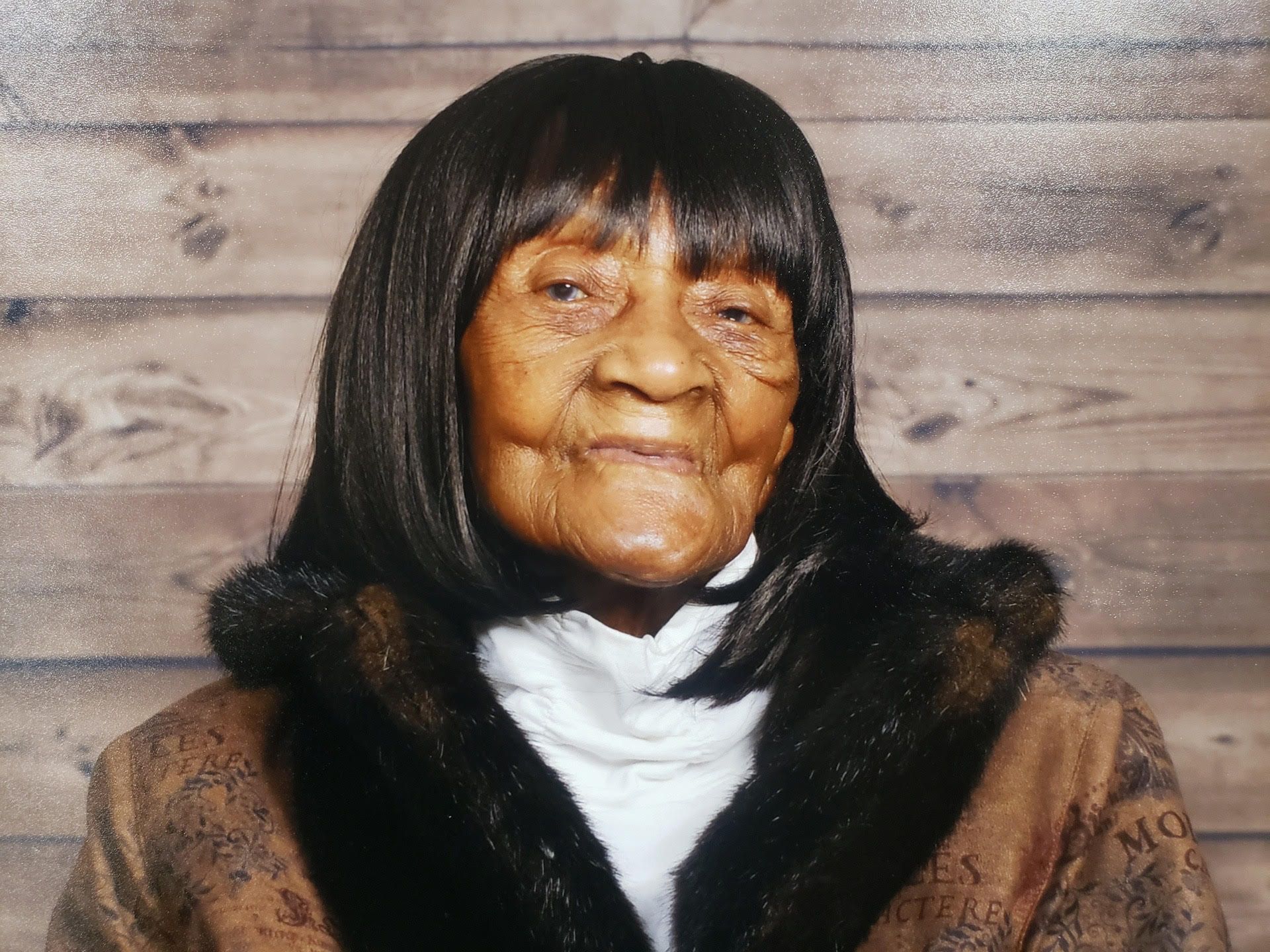
A whistle rang out in Greenwood on May 31, 1921. Residents in the affluent Black community initially did not know what it signified, but it became clear in the hours that followed: It was a riot call. “I was just investigating, seeing what was going on,” Lessie Benningfield Randle says, recalling the confusion surrounding that day. “The shooting began, and we knew something was unusual, but we didn’t know exactly what until we investigated and we found out it was a riot. It was quite something.” The then-6-year-old was at her grandmother’s house in the Greenwood district of Tulsa, Oklahoma—a bustling area that included Black Wall Street. She quickly grasped the gravity of the situation when soldiers came to the front door and escorted her, her grandmother, and her uncle to Tulsa County Fairgrounds, one of two centers where the National Guard interned more than 6,000 Black people, some for up to eight days. “The soldiers came, and they took us to the fairgrounds so that we would be out of danger if the ‘rebels’ came to harm us. They took us where we would be safe,” Randle says.
“I was quite small, and I don’t remember what they told me, but they did tell me that a riot was going on,” she continues. Randle does not recall if her grandmother specifically told her what was happening at the time, as she may not have known herself, but word quickly spread about a mob of hundreds of whites—men and boys that the local police had made “special deputies”—looting and torching the 35 city blocks of the prosperous Black neighborhood amid rumors that Dick Rowland, a 19-year-old Black shoeshiner, had assaulted a 17-year-old white girl named Sarah Page at the Drexel Building in Greenwood. It is now believed that Rowland, in fact, simply tripped in the elevator and somehow grabbed Page, who worked as an elevator attendant. According to historical accounts, police instructed the mob, “Get a gun, and get a n*****.”
By the early hours of June 1, martial law had been implemented and the National Guard was in Tulsa. Randle’s parents were farming in Bixby, roughly 24 miles away, when they learned of the unrest, prompting them to head to Tulsa on their wagon. Randle says she was given food at the fairgrounds, which she describes as being “mangled and mixed all up.” She and her family spent the night there, sleeping on cots, before her parents picked them up. “I felt real strange. It’s a place I hadn’t been before. And I was just wondering why we had to be there.”
The destruction she returned to the next morning still haunts Randle a century later. “Some of [the buildings] they burned. Some they tore up,” Randle says. “It was quite something to see.…I never want to see anything like that again.”
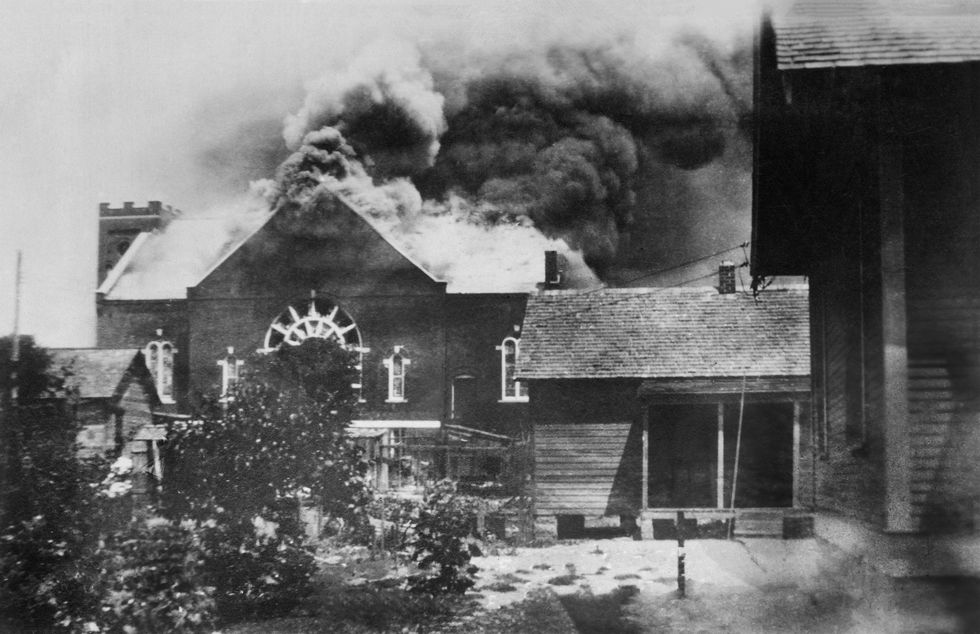
A church burns during the Tulsa Massacre.
At 106 years old, Randle, affectionately called Mother Randle by her friends and family, is one of the last remaining survivors of the 1921 Tulsa Race Massacre. She is a soft-spoken, tiny woman with an equally soft laugh and striking smile who attributes her longevity (or what she would call her youth) to living on the land as her parents and grandmother did. The centenarian doesn’t even wear glasses.
The devastation Randle lived through as a child was immediately downplayed by officials. Initial reports claimed dozens of Black people were killed; historians now estimate as many as 300 Black people died and 8,000 were injured in the massacre, an incident many deem the deadliest single occurrence of racial violence to have transpired on American soil. Tulsa World reported that national guardsmen used machine guns to kill dozens of African Americans in Greenwood, and while the National Guard categorically denied those allegations, Mary Jones Parrish, in her book Events of the Tulsa Disaster, wrote that she witnessed machine-gun fire. In October 2020, researchers excavating Tulsa’s Oaklawn Cemetery discovered a mass grave containing 12 unmarked coffins believed to contain victims of the massacre. And Randle told Oklahoma State University researchers in 2015 that rioters targeted Black men, whose bodies were rumored to have been stacked in a truck before they were dumped into a river.
The enduring framing of the 1921 Tulsa Race Massacre as a “race riot” suggests that Black Greenwood residents somehow played an antagonistic role in the violence inflicted on them. And the whitewashing of the horror that transpired in those 24 hours persists 100 years later. The massacre notably remains absent from most public schools’ curricula, though the incident garnered new interest after it was depicted in an episode of HBO’s Watchmen in 2019.
Get exclusive access to fashion and beauty trends, hot-off-the-press celebrity news, and more.
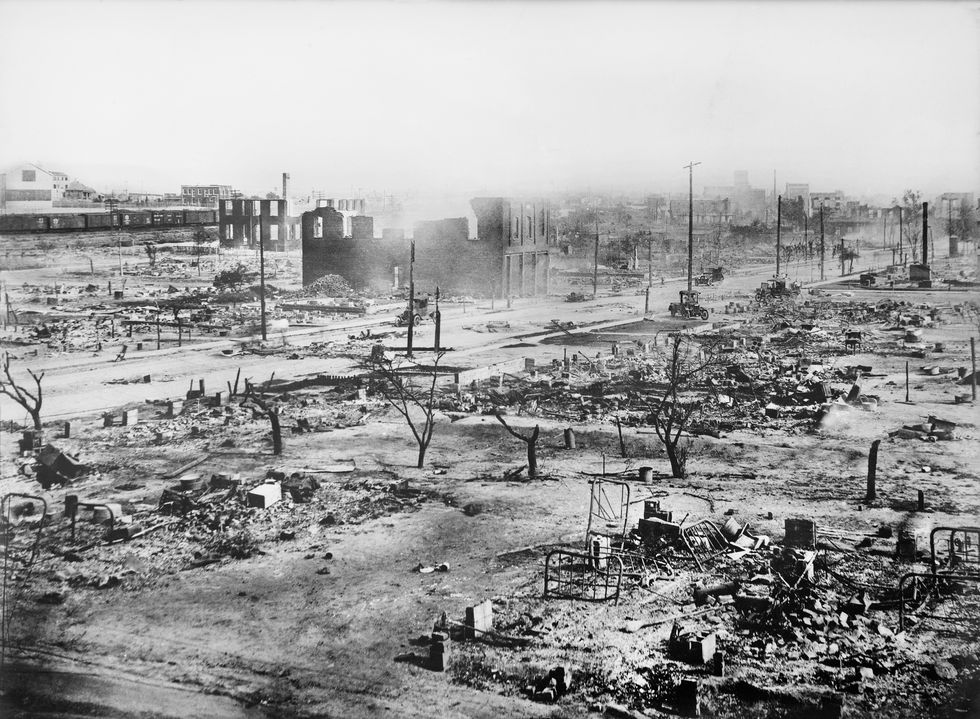
The ruins of the Greenwood district.
“The Greenwood community was a nationally renowned economic entrepreneurial community,” says Hannibal Johnson, author of Black Wall Street 100: An American City Grapples With Its Historical Racial Trauma. Whites’ animosity toward Black Wall Street—an area in Greenwood that flourished in the Jim Crow era—reached a tipping point that fateful day in 1921, and they latched on to any story, no matter how untrue, as an excuse to attack innocent people. But Black Tulsans were committed to rebuilding after the massacre. In 1925, the Greenwood district hosted the annual Booker T. Washington’s National Negro Business League conference, and in the decades that followed, it was home to 200 Black-owned businesses. “It was devastated in the 1921 Tulsa Race Massacre,” Johnson says, but Greenwood “was built to a greater degree immediately thereafter. I’d say the rebuilding began even while the ashes were still smoldering.”
Although citizens’ efforts to rebuild Greenwood were not in vain, the 1921 Tulsa massacre did inflict lasting generational trauma upon countless Black families like Randle’s. Randle lives in North Tulsa, as do 41 percent of Black people in the city. In 2019, Human Rights Watch found that the neighborhood had higher rates of unemployment and poverty and a lower life expectancy than the rest of the city. Black Tulsans are 2.3 times more likely to be arrested than their white counterparts. North Tulsa does not have a single hospital.
Such disparities do not disappear without direct action, which is why, in September 2020, Randle joined an unprecedented lawsuit seeking reparations for the massacre. Randle and two other centenarians who experienced the massacre firsthand are listed as plaintiffs alongside several descendants whose families had businesses destroyed in the state-sanctioned attack. They are seeking damages from various government agencies, including the city of Tulsa and the Oklahoma Military Department. “I certainly do want justice to be served,” Randle says. “I want justice to be served, as it should be.” And while her lawyers fight for reparations, what Randle says she wants in the meantime appears modest: “I tell ya, what I would like is a comfortable home—not a great, big home, but a comfortable home,” she says. “I’d appreciate if I can get a comfortable home now that I’m 106 years old.”
McKenzie Haynes, an associate at the New York–based law firm Schulte Roth & Zabel, and Damario Solomon-Simmons, an attorney in private practice in Tulsa, are representing the massacre victims and their descendants. “If we can improve the community broadly, that would be the most profound reparations lawsuit success story this country has ever seen, because so much racial violence and the things that have happened in America for so long have created this systemic problem,” Haynes says. “When you look at pictures in the community and you see the destitute environment and the people living in it, it just breaks your heart.”
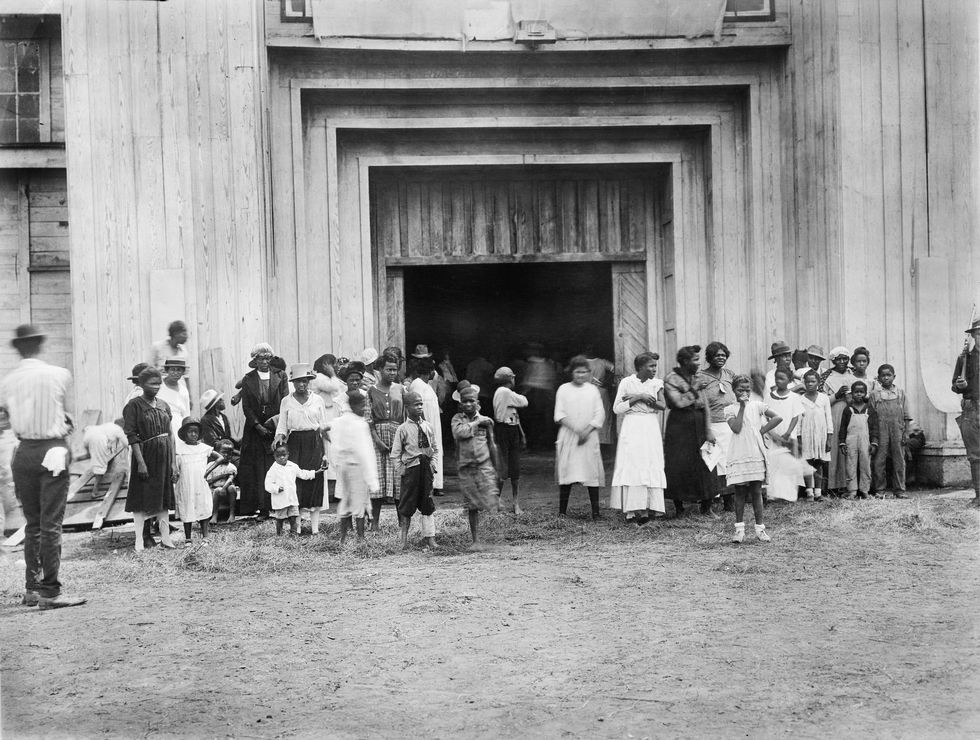
A group of refugees gather at the entrance to the Fairgrounds, where the National Guard interned 6,000 Black Tulsans.
What’s paramount about the lawsuit is that it seeks damages through Oklahoma’s public-nuisance law. Solomon-Simmons said he got the idea after learning of state officials who cited the ordinance in a 2019 case in which Johnson & Johnson was later ordered to pay $572 million for its involvement in the opioid crisis. Solomon-Simmons says public-nuisance lawsuits aim to remedy the individual who was harmed, like Randle, and the community. He uses an example of someone dumping a large pile of trash in front of your home to explain how the massacre and the opioid crisis have striking similarities: “The trash was stinking and it had rats, it had maggots, it had roaches.…That would be the nuisance. The trash sits there for years and years and years, and it causes additional problems. And as it continues, it made people sicker. People died. Properties, communities eroded, and it cost us more time and energy,” he says. “And therefore, you need to update it. You need to fix it. If that trash pile is still in the way, you want them to remove the trash and everything that happened because of the trash. That’s what the state of Oklahoma did with the opioid companies, and that’s what we’re simply saying for Greenwood.”
Reparations is a loaded term in American politics, but moving forward requires atoning for the past. Tulsa remains a city marred by institutional racism and generational trauma—a far cry from an area that once attracted entrepreneurs from all over the country. “You had a thriving, self-sustaining community of Black people,” Haynes says. “And the transfer of wealth, which happens so often in other communities that are not impacted by these sorts of atrocities, that never got to happen here.”
Understanding how people tacitly benefit from systemic racial oppression while others are harmed by it is as easy as picturing a game of Monopoly. As author Kimberly Jones put it during a Black Lives Matter protest following the death of George Floyd last year: “For 400 rounds of playing Monopoly, I didn’t allow you to have any money. I didn’t allow you to have anything on the board. I didn’t allow for you to have anything, and then we played another 50 rounds of Monopoly and everything that you gained and you earned while you were playing that round of Monopoly was taken from you.” She points to affluent Black cities like Tulsa and Rosewood, Florida, as prime examples of this twisted game; they were destroyed and had their wealth stolen but were never fully remedied. “How can you win? How can you win? You can’t win. The game is fixed,” Jones goes on to say in an impassioned, impromptu speech that garnered international attention. “They are lucky that what Black people are looking for is equality and not revenge.”
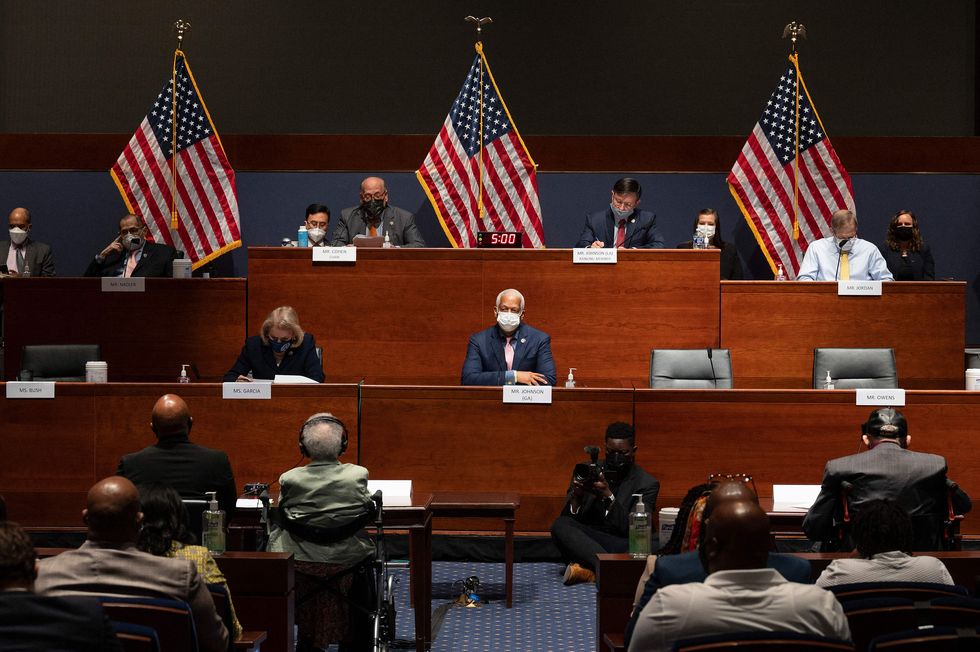
Tulsa Massacre survivors Hughes Van Ellis (far right) and Viola Fletcher (second from left) testify before congress on May 19, 2021
This year, on the 100th anniversary of the Tulsa Race Massacre, acknowledgement of the tragedy should not be the only takeaway. “The real story is the story of the human spirit,” says Johnson. “It’s really about the Black community here [in Tulsa], the community’s character in terms of its fortitude, faith, hope, resilience.” Those qualities still characterize Tulsa, even as the ashes of institutional racism and generational trauma continue to smolder.
In March last year, the neighborhood fundraised and restored Mother Randle’s childhood home, which was destroyed in the Massacre. Solomon-Simmons stresses that it was community leaders like Tiffany Crutcher, a local activist whose twin brother, Terrence, was fatally shot by Tulsa police in 2016, who were responsible for the crowdfunding efforts, not government officials, who he says have shirked responsibility while treating the Tulsa Massacre like a cash grab and tourist attraction. Solomon-Simmons points out that the 1921 Tulsa Race Massacre Centennial Commission used $20 million of the $30 million raised to build the Greenwood Rising history center, slated to open in June; none of the money has gone to survivors like Randle. Just two weeks ago, Human Rights Watch released a scathing report backing this allegation. “They’re raising $30 million, and the Randles are living in poverty, worrying about their bills, hoping to have a better home. It’s absurd, it’s shameful, and it’s unconscionable,” says Solomon-Simmons.
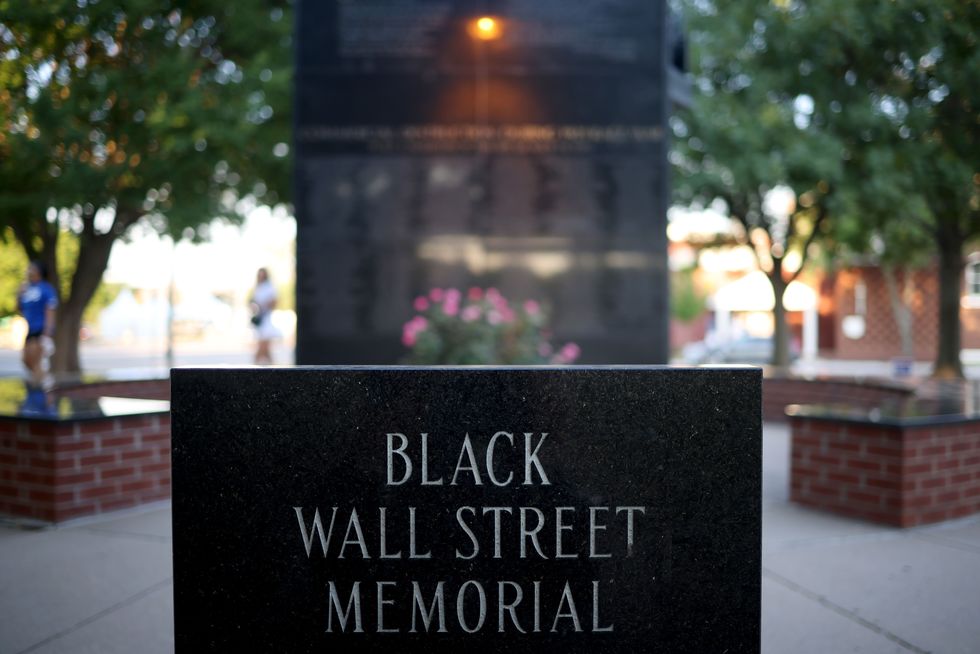
The Tulsa Massacre Memorial in Tulsa, Oklahoma.
But Mother Randle is turning that shame into strength. On May 19, she spoke before Congress about reparations for Tulsa Massacre victims. It is not something a 106-year-old woman should have to do, but she calls the chance to finally do so “a blessing.” “It means a lot to me to finally be able to look at you all and ask you to do the right thing. I have waited so long for justice,” she said as she read off a paper. “I am asking for things to be made right.”
Jacquelyn Gray is a New Jersey-based journalist who covers news at Crime Online. You can view more of her work at JacquelynGray.com.
